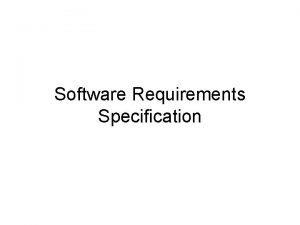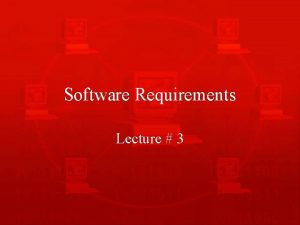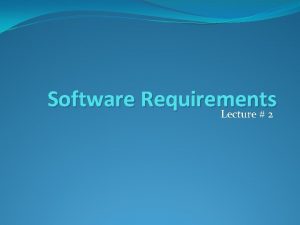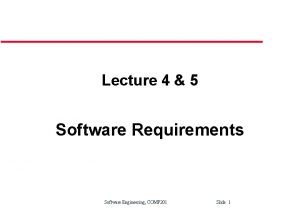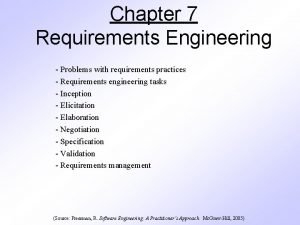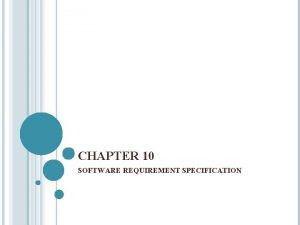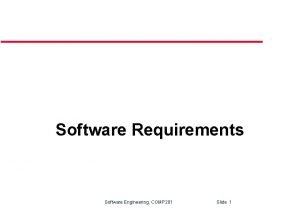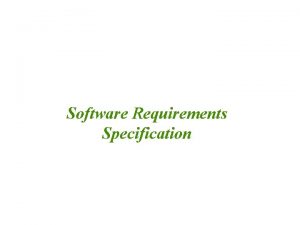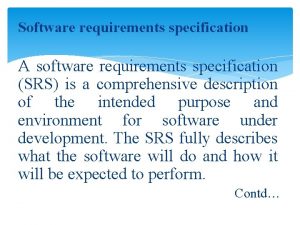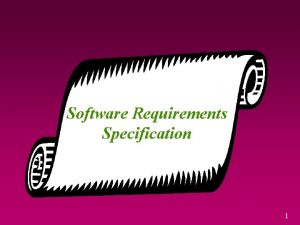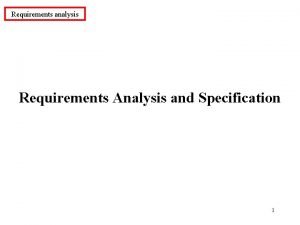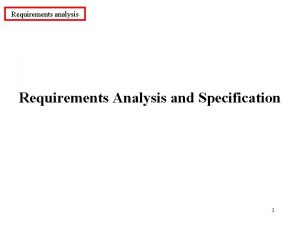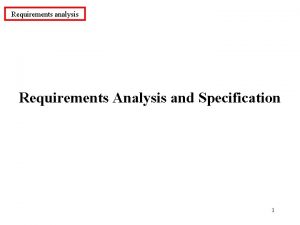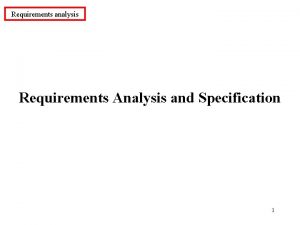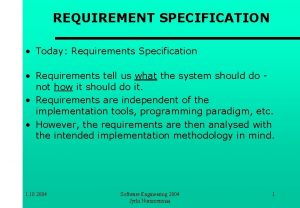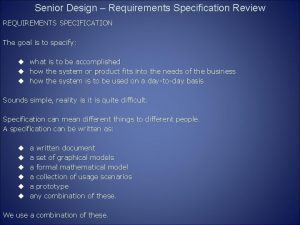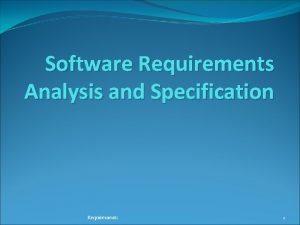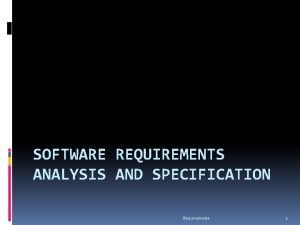Software Requirements Analysis and Specification Requirements Engineering Requirements
















- Slides: 16

Software Requirements Analysis and Specification

Requirements Engineering Requirements Elicitation Requirements Specification Requirements Management Requirements Analysis Requirements Verification

Requirements Engineering n n n Stakeholder identification Stakeholder interviews Contract-style requirement lists Measurable goals Prototypes Use cases

Requirements Engineering n n n Eliciting requirements: the task of communicating with customers and users to determine what their requirements are. This is sometimes also called requirements gathering. Analyzing requirements: determining whether the stated requirements are unclear, incomplete, ambiguous, or contradictory, and then resolving these issues. Recording requirements (specification): Requirements might be documented in various forms, such as natural-language documents, use cases, user stories, or process specifications.

Eliciting Requirements n Analysts can employ several techniques to elicit the requirements from the customer. n n interviews, focus groups (requirements workshops) and creating requirements lists. prototyping, and use cases. combination of these methods

Software Requirement Analysis n n Determining the needs or conditions to meet for a new or altered product, In other words, process of studying and analyzing the customer and the user/stakaholder needs to arrive at a definition of software reqiurements. Requirements must be actionable, measurable, testable, related to identified business needs or opportunities, and defined to a level of detail sufficient for system design. Requirements can be functional and non-functional.

Types of Requirements n n Functional requirements Performance requirements n n n External interface requirements Design constraints n n Speed, accuracy, frequency, throughput Requirements are usually about “what”, this is a “how”. Quality attributes n i. e. reliability, portability, maintainability, supportability

Requirements vs. Design Requirements Design Describe what will be delivered Describe how it will be done 3 Primary goal of analysis: UNDERSTANDING Primary goal of design: OPTIMIZATION There is more than one solution There is only one (final) solution Customer interested Customer not interested (Most of the time) except for external

Software Quality Attributes n n n n Correctness Reliability n Rating = 1 – (Num Errors/ Num LOC) n Can be allocated to subsystems Efficiency Integrity Usability Survivability Maintainability Verifiability Flexibility Portability Reusability Interoperability Expandability

Requirements Analysis Defining Stakeholder profiles n n n n Description - brief description of the stakeholder type Type - Qualify s-h’s expertise, technical background, degree of sophistication Responsibilities - List s-h’s key responsibilities with regard to the system being developed - why a stakeholder? Success Criteria - How does the stakeholder define success? How rewarded? Involvement - involved in the project in what way? Requirements reviewer, system tester, . . . Deliverables* - required by the stakeholder Comments/Issues - Problems that interfere w/ success, etc.

Requirements Analysis Defining User Profiles n n n n Description - of the user type Type - qualify expertise, technical background, degree of sophistication Responsibilities - user’s key resp. ’s w. r. t. system being developed Success Criteria - how this user defines success? rewarded? Involvement - How user involved in this project? what role? Deliverables - Are there any deliverables the user produces? For whom? Comments/Issues - Problems that interfere w/ success, etc. n This includes trends that make the user’s job easier or harder

Requirements Analysis Defining User Work Environment n n n Number of people involved in doing this now? Changing? How long is a task cycle now? Changing? Any unique environmental constraints: mobile, outdoors, in-flight, etc. Which system platforms are in use today? future? What other applications are in use? Need to integrate?

Requirements Analysis Product Overview Put the product in perspective to other related products and the user’s environment. Independent? Component of a larger system? How do the subsystems interact with this? Known interfaces between them and this component? Block diagram

Requirements Analysis Other Product Requirements n n hardware platform requirements -system requirements -- supported host o. s. ’s, peripherals, companion software environmental requirements -- temperature, shock, humidity, radiation, usage conditions, resource availability, maintenance issues, type of error recovery applicable standards -- legal, regulatory, communications

Requirements Analysis n n Fundamental Techniques (Views) functional view n hierarchy - function tree n process use cases n information ow data flow diagram (DFD) data oriented view n data structures data dictionary (DD), syntax diagram, Jackson diagram n relations between entities entity relationship diagram (ER) object-oriented view n class structure class diagram

Requirements Analysis n n algorithmic view n control structures n pseudo code, structogram, flow diagram, Jackson diagram n conditions rules, decision table state-oriented view n state machines n Petri nets n sequence charts
 Upper specification limit and lower specification limit
Upper specification limit and lower specification limit Natural variations operations management
Natural variations operations management Requirement vs specification
Requirement vs specification Software requirement analysis and specification
Software requirement analysis and specification Software metrics example
Software metrics example What is system design in software engineering
What is system design in software engineering Forward engineering and reverse engineering
Forward engineering and reverse engineering Inverse requirements
Inverse requirements Inverse requirements
Inverse requirements Structured specification
Structured specification Requirements discovery techniques in software engineering
Requirements discovery techniques in software engineering Domain requirements examples
Domain requirements examples Domain requirements
Domain requirements What is domain requirements in software engineering
What is domain requirements in software engineering Inception elicitation elaboration negotiation
Inception elicitation elaboration negotiation Value of good srs in software engineering
Value of good srs in software engineering Requirements in software engineering
Requirements in software engineering


